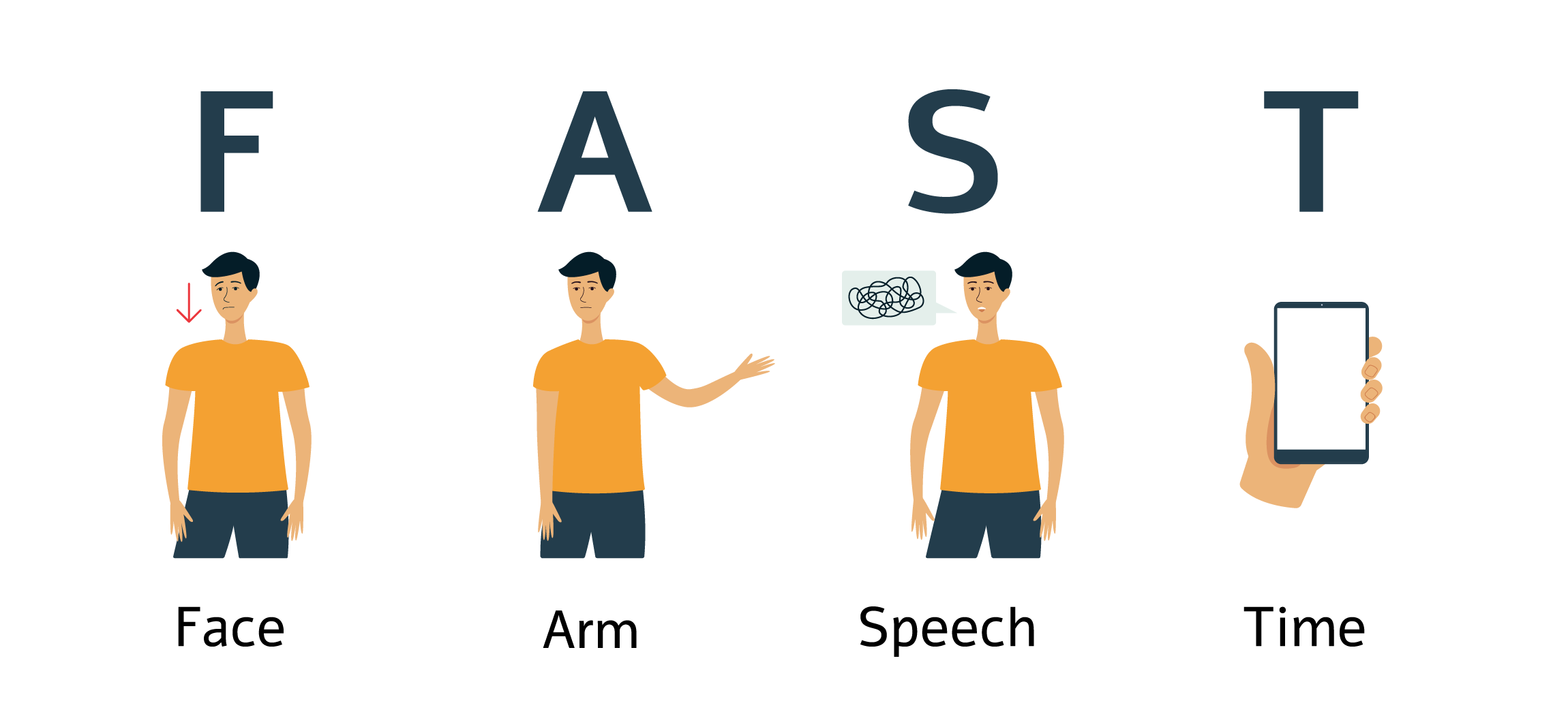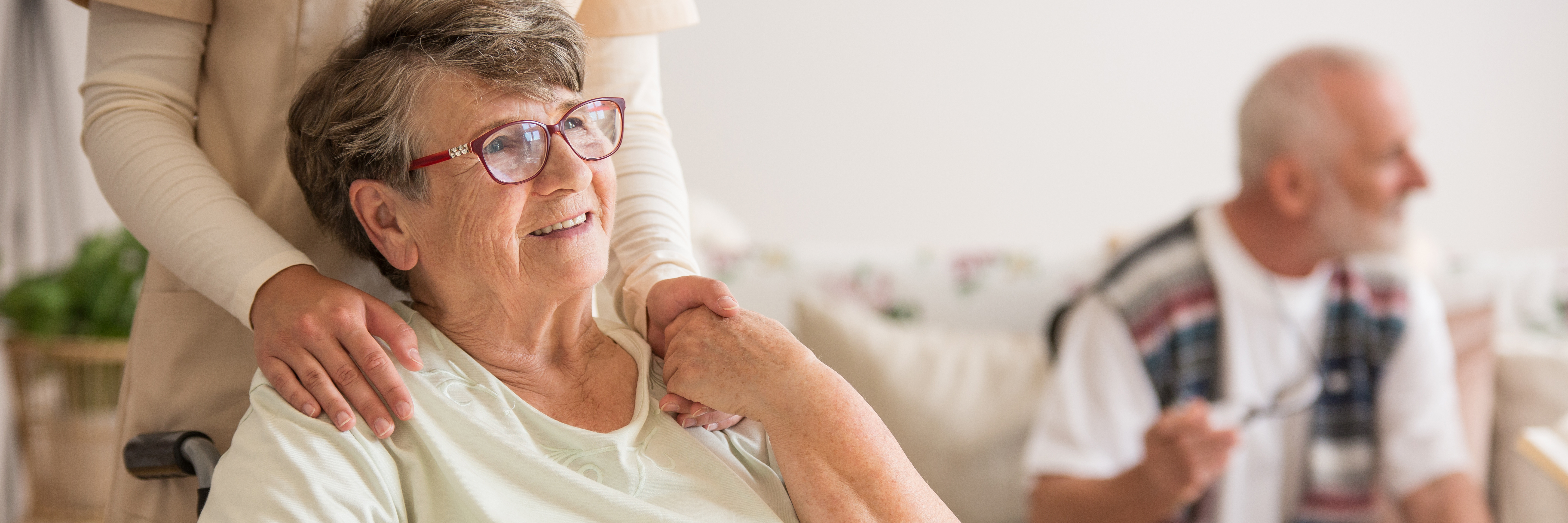Stroke
Symptoms and causes
Symptoms and causesA stroke or cerebrovascular accident (CVA) is an acute medical condition characterised by a sudden disruption of blood flow to the brain.
Strokes can be divided into cerebral infarctions and brain haemorrhages.
In Belgium, an average of 52 people suffer a stroke every day.
In the case of a stroke, one or more of the following symptoms occur suddenly:
- Sensory impairments or paralysis on one side of the body or face
- Speech and language disorders: difficulty in articulating, finding or understanding words
- Loss of vision in one or both eyes
- Half-sided visual field loss in both eyes
- Loss of balance
- Issues with coordination
- A very severe headache: the so-called 'thunderclap headache’, the worst imaginable headache that comes on very suddenly (a fraction of seconds)
When these symptoms resolve quickly on their own (after minutes or hours), it is referred to as a TIA (transient ischemic attack).
B.E.F.A.S.T. test
B.E.F.A.S.T. test
You can easily recognise the symptoms with the B.E.F.A.S.T. test:
- Balance: are there sudden balance disturbances or an unsteady gait?
- Eyes: are there any problems with sight or eye movement?
- Face: is the mouth drooping or uneven?
- Arm: does an arm and/or leg move less efficiently?
- Speech: is there unclear or slurred speech?
- Time: respond immediately and call 112, every minute counts.
Causes
Causes85% of all strokes are cerebral infarctions. A cerebral infarction occurs when a blood vessel suddenly becomes blocked or allows less blood to a part of the brain. As a result, that area of the brain receives insufficient blood and oxygen, leading to damage or death of brain cells.
The blood supply to that area of the brain may be interrupted due to several causes:
- A blood clot formed elsewhere in the body (e.g. in the heart) travels through the blood stream via the arteries and suddenly becomes lodged in a brain blood vessel, blocking the blood flow to that area. This is called an embolism.
- A blood vessel can become narrowed or blocked due to arteriosclerosis, causing it to become clogged and eventually preventing blood from flowing through. This can occur in a large supplying blood vessel in the neck or a smaller blood vessel within the brain itself.
- There are also other, rarer causes, which your neurologist will explain if they are relevant for you.
Cerebral infarctions are diagnosed with a CT or an NMR scan.
15% of all strokes are caused by a brain haemorrhage. A brain haemorrhage occurs when a blood vessel in the brain is damaged and blood leaks into the brain. Sometimes, the blood is only around the brain, but other times it leaks into the brain tissue and damages brain function. This can cause increased pressure in the skull, leading to drowsiness and vomiting in the patient. High blood pressure or a weakened blood vessel wall (aneurysm) are the major causes of a brain haemorrhage.
Brain haemorrhages can also be caused by taking strong blood-thinning medication.
Brain haemorrhages can be caused by an accident or by trauma. The mechanism of bleeding may be different, but the consequences and treatment are similar to those in the case of a spontaneous brain haemorrhage.
Cerebral amyloid angiopathy is a condition that can cause both brain haemorrhages and cerebral infarctions. This is due to the accumulation of an abnormal protein (amyloid-beta) in the walls of brain-blood vessels, making them vulnerable.
In a venous sinus thrombosis, the issue is in the brain's draining blood vessels. A clot in a draining blood vessel prevents blood from leaving a part of the brain, causing damage to that area.
This is the opposite of a classic stroke, where a blockage occurs in a supplying artery.
The symptoms primarily include headache, but sometimes also epilepsy, reduced consciousness and, in some cases, neurological deficits similar to those of a classic cerebral infarction.
There are also other, less frequent causes of stroke. For individual information about these rarer conditions, you can always consult the neurologist at your hospital.
Treatment at the Accident and Emergency (A&E)
Treatment at the Accident and Emergency (A&E)With signs of stroke, patients should come to A&E as soon as possible. 'Time is brain'. The sooner you are in hospital, the better the treatment options.
After questioning and a clinical exam of the patient, a brain scan will be performed as soon as possible if a stroke is suspected. Then, we will know whether it is a brain haemorrhage or a cerebral infarction. Next, the neurologist, in consultation with the radiologist, will discuss the diagnosis and treatment options with the patient or his or her representative.
When a cerebral infarction occurs, supportive measures are always taken and preventive treatment is also initiated to avoid new infarctions. In certain cases, and provided the patient arrives at the A&E very quickly, more specialised treatments may be possible. The timing and speed of these specific treatments are crucial for the patient’s chances of recovery.
- Thrombolysis: a clot-dissolving drug is administered via IV to try to reduce or dissolve the clot.
- Thrombectomy: a catheter is inserted into the groin and advanced to the blood vessels in the brain, where efforts are made to trap and remove the clot by withdrawing the catheter. In all of Flanders, only a few hospitals are authorised to perform this procedure. Within the E17 Hospital Network, there is a team of specialised radiologists who can perform this procedure. If this treatment is indicated, any patient of a hospital in the E17 Hospital Network can access this procedure.
In the event of a brain haemorrhage, the primary focus is to take measures to prevent additional damage to the brain
- lower the blood pressure
- improve clotting
- avoid increased pressure in the brain
For certain types of bleeding caused by abnormally formed blood vessels (e.g. aneurysms), the problem is identified and treated by an interventional radiologist or neurosurgeon. In the case of a brain (or meningeal) haemorrhage, there is also a consult with a neurosurgeon to assess whether surgical intervention is necessary to stop the bleeding or to reduce the pressure on the brain.
Course of the hospitalisation
Course of the hospitalisationAfter acute care in the A&E, the patient is admitted for specialist care on the Stroke Unit. Here, patients receive continuous neurological and cardiac rhythm monitoring. Patients may be admitted to the Intensive Care Department when more intensive treatment e.g. ventilation) is needed.
On the Stroke Unit, patients are cared for by specifically trained nurses and there is the possibility of continuous monitoring of the brain, heart and lung functions. A multidisciplinary team initiates treatment and rehabilitation immediately. There is smooth cooperation between the neurologists and the radiology and cardiology departments as well as with the rehabilitation physician. Patients can often leave this specialised department after 48 hours. Sometimes, patients have recovered enough to go home, while in other cases, further admission to the Neurology Department or later to the Rehabilitation Department may be necessary.

Consequences of a stroke
Consequences of a strokeStrokes are a leading cause of death and also a major cause of disability. The symptoms that occur and their degree of recovery depend on the type of stroke, the part of the brain that is damaged, and the size of the affected area.
Some of the possible symptoms include:
- paralysis, often affecting one side of the body
- spasticity = stiffness
- vision issues: loss of one of the visual fields or double vision
- memory disturbances, concentration issues, cognitive impairments
- speech and comprehension problems
- difficulty chewing/swallowing
- behavioural changes
- depression, lack of initiative, loss of interest
- dizziness, impaired balance
- urinary problems, incontinence
- epileptic seizures
- fatigue
These impairments can be permanent and have a significant impact on daily functioning and quality of life. After a stroke, the patient is also subject to a legal driving ban for at least six months.
More information
More informationInformation sessions for patients and family members are regularly organised within the E17 Hospital Network at the different hospitals. At these free information sessions, you'll learn about what a stroke is, the potential risk factors and the treatment options. We want to address the many questions you may have. These information sessions are for patients and their informal carers or close relatives, as well as interested parties. These sessions are regularly repeated. You can choose for yourself which information session(s) you wish to attend. Registration is required.
More information
Treatment centres and specialisations
Treatment centres and specialisations
Latest publication date: 25/10/2024
Supervising author: Dr Aers Isabelle
Something wrong or unclear on this page? Report it.
Supervising author: Dr Aers Isabelle




